
Nuclear power plants use high-pressure pumps for two major critical services.
1) Boronated Water Pump Plants:
Plants with pressurized-water reactors are designed to bleed liquid (a weak nitric acid solution called "boronated water") from the pressurized primary coolant loop.
This "loss" is from mechanical seals in the large centrifugal circulating pumps, and through a throttling valve.
This fluid is cleansed and returned to the high-pressure loop (at approximately 2300 psi) with high-pressure pumps.
2) Fueling Machine Supply Pumps:
Nuclear power plants that utilize boiling water reactors use high-pressure pumps in a service called "Standby Liquid Control.".
These SLC units are part of the emergency shut-down system. If normal methods of controlling a nuclear reactor fail, these units pump sodium pentaborate into the reactor to shut the unit down.
Maximum working pressure: 200 Kg/cm2
Maximum Discharge flow rate: 25 m3/hr